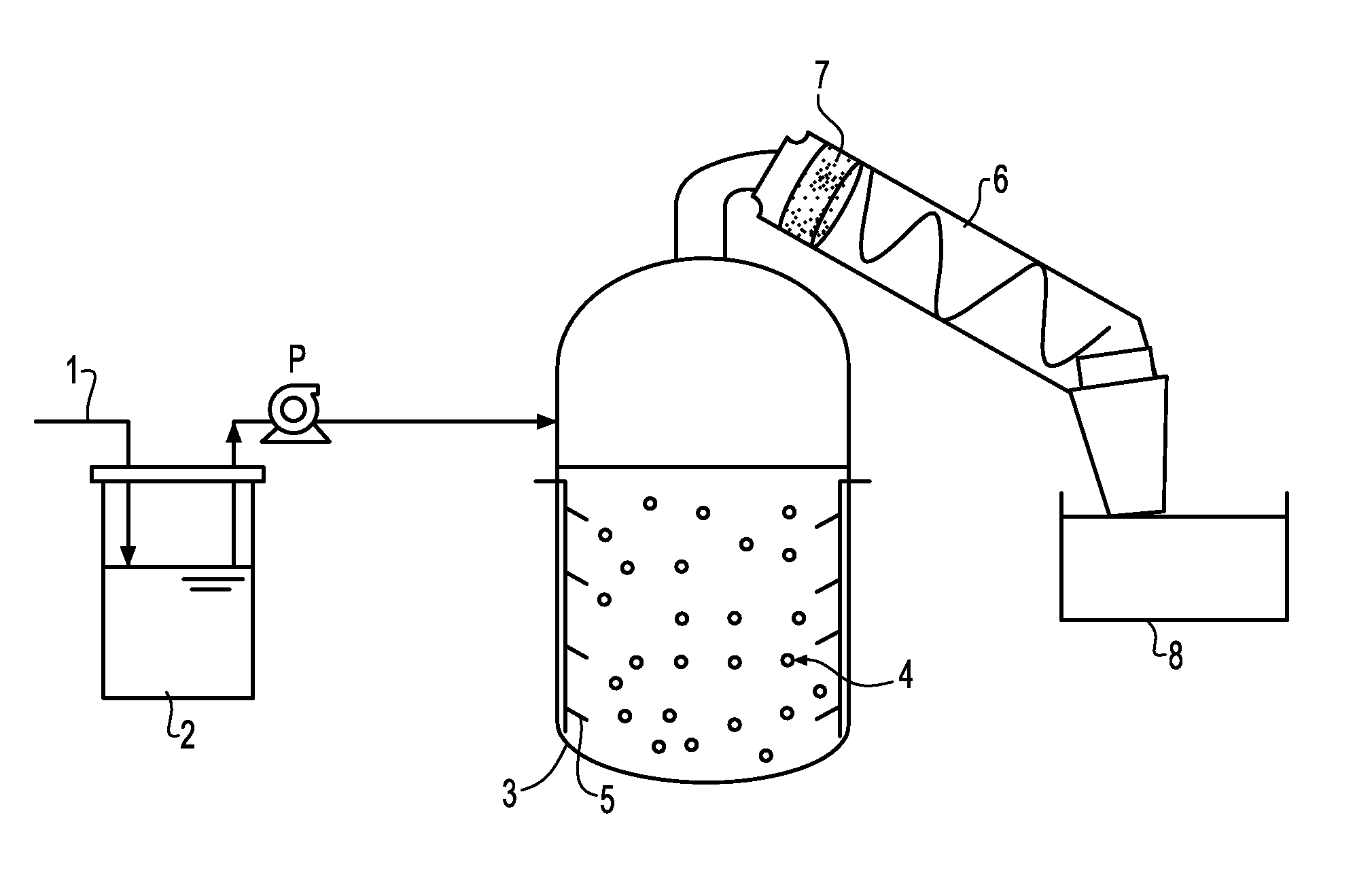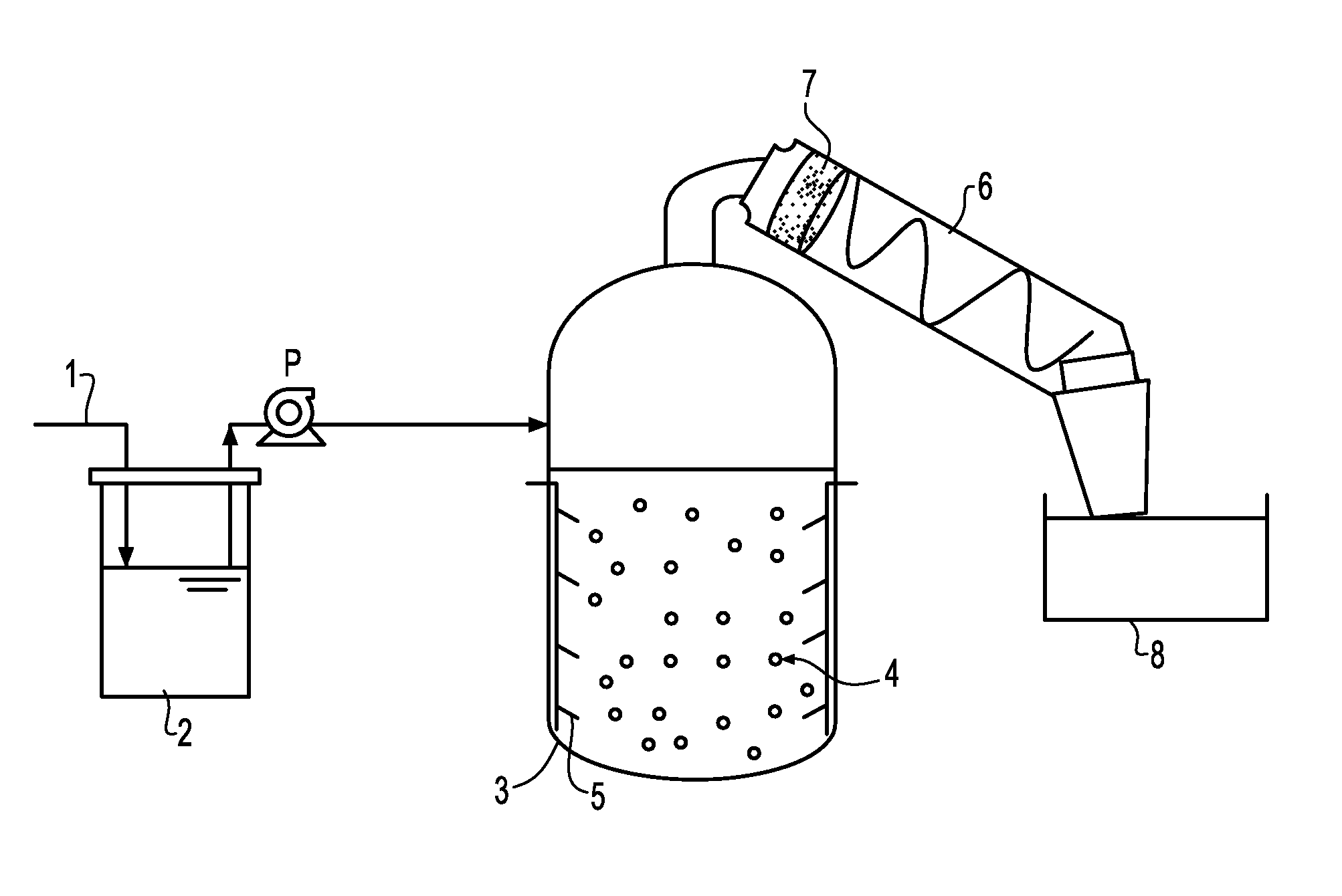Method for sewage and industrial wastewater treatment
a technology for industrial wastewater and sewage, applied in the direction of gravity filters, loose filtering material filters, cation exchangers, etc., can solve the problems of high cost and time consumption, and none of the above-discussed references discloses or suggests a cost effective and time-saving method for reducing both bacterial and chemical concentrations, so as to and reduce the concentration of said pollutants
- Summary
- Abstract
- Description
- Claims
- Application Information
AI Technical Summary
Benefits of technology
Problems solved by technology
Method used
Image
Examples
example 1
[0033]As illustrated in the FIGURE, wastewater 1 containing contaminant levels as set forth in the tables below, was pumped into a tank 2 through a screen to remove solid materials. 1000 mL of the raw wastewater from the tank was then passed through pump P into an evaporator vessel 3, mixed with 10 g bentonite clay 4, and the mixture was aerated with spargers 5 and stirring for a period of one hour at ambient temperature to reduce the BOD. Then the temperature of the mixture was increased to 70° C., and stirring and aeration was continued for another one half hour to allow the volatile materials to escape from the system, thus reducing COD. Subsequently, a condenser apparatus 6, containing a Pyrex® disc membrane 7 was placed on top of the evaporator vessel, and the temperature in the evaporator vessel was raised to 100° C., without aeration. Water vapor was evaporated from the wastewater / bentonite mixture and passed through the Pyrex® disc membrane under its own pressure, condensed ...
example 2
[0034]The second example was conducted in the same manner as in Example 1, except that the aeration time at ambient temperature was increased from 1 to 2 hours. The results of the treatment process are set forth in Table 2, below. (Note: raw wastewater volume=1000 ml).
TABLE 2ConcentrationConcentrationbefore treatmentafter treatment%Analysis(mg / L)(mg / L)removalBOD1985672COD91693.4TC106.910.5390.2TOC39.531.3196.7IC67.429.2386.3HCO31683281Ca1377.994.2Mg140.3597.5Na1978.495.73K6.90.3195.5Cl328598.5SO4131497NO31181.898.5
[0035]It is observed from the results that the COD reduction was significant and the removal efficiency increased from 78.5% to 93.4%, as compared to Example 1.
example 3
[0036]The third example was conducted essentially in the same manner as in Example 1, except that 20 g of bentonite clay was used. The results of the treatment process are set forth in Table 3, below. (Note: raw wastewater volume=1000 ml).
TABLE 3ConcentrationConcentrationbefore treatmentafter treatment%Analysis(mg / L)(mg / L)removalBOD2614483.2COD593442.4TC116.74.1996.4TOC40.071.3096.8IC76.622.8996.2HCO31721392.2Ca1401.998.6Mg240.3298.7Na1764.697.4K50.296Cl2961.999.4SO41640.899.5NO31271.798.7
[0037]It is observed from the results that the BOD reduction was significant and the removal efficiency increased from 74.9% to 83.2%, as compared to Example 1. However, there was no significant change in reductions of cations and anions.
PUM
| Property | Measurement | Unit |
|---|---|---|
| temperature | aaaaa | aaaaa |
| temperature | aaaaa | aaaaa |
| temperatures | aaaaa | aaaaa |
Abstract
Description
Claims
Application Information
 Login to view more
Login to view more - R&D Engineer
- R&D Manager
- IP Professional
- Industry Leading Data Capabilities
- Powerful AI technology
- Patent DNA Extraction
Browse by: Latest US Patents, China's latest patents, Technical Efficacy Thesaurus, Application Domain, Technology Topic.
© 2024 PatSnap. All rights reserved.Legal|Privacy policy|Modern Slavery Act Transparency Statement|Sitemap


